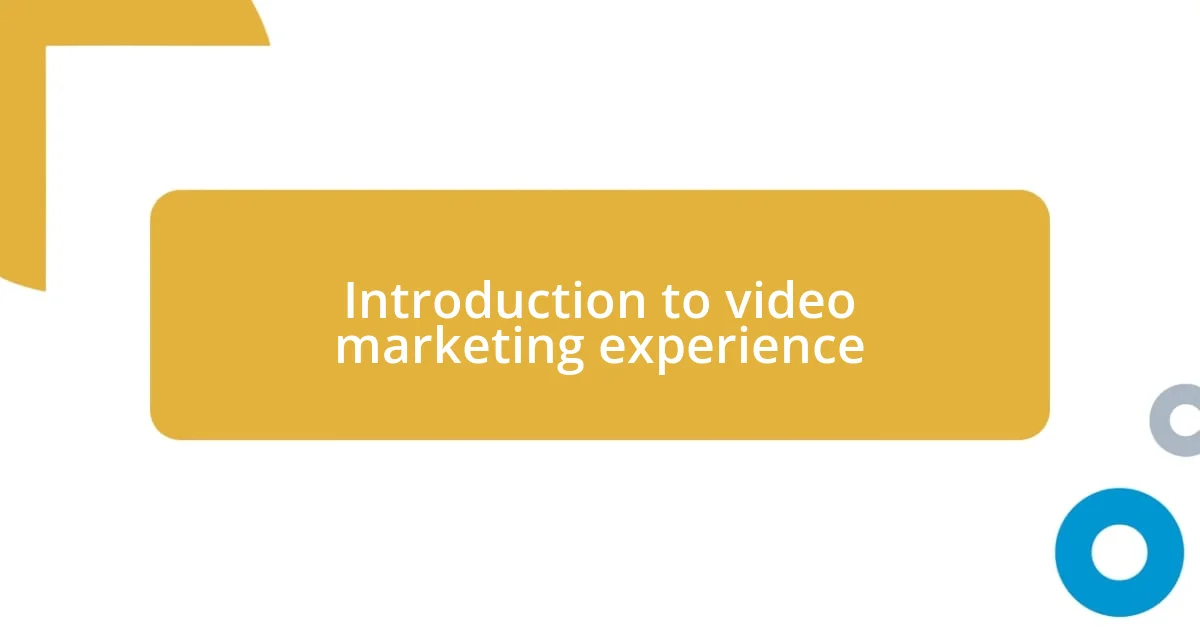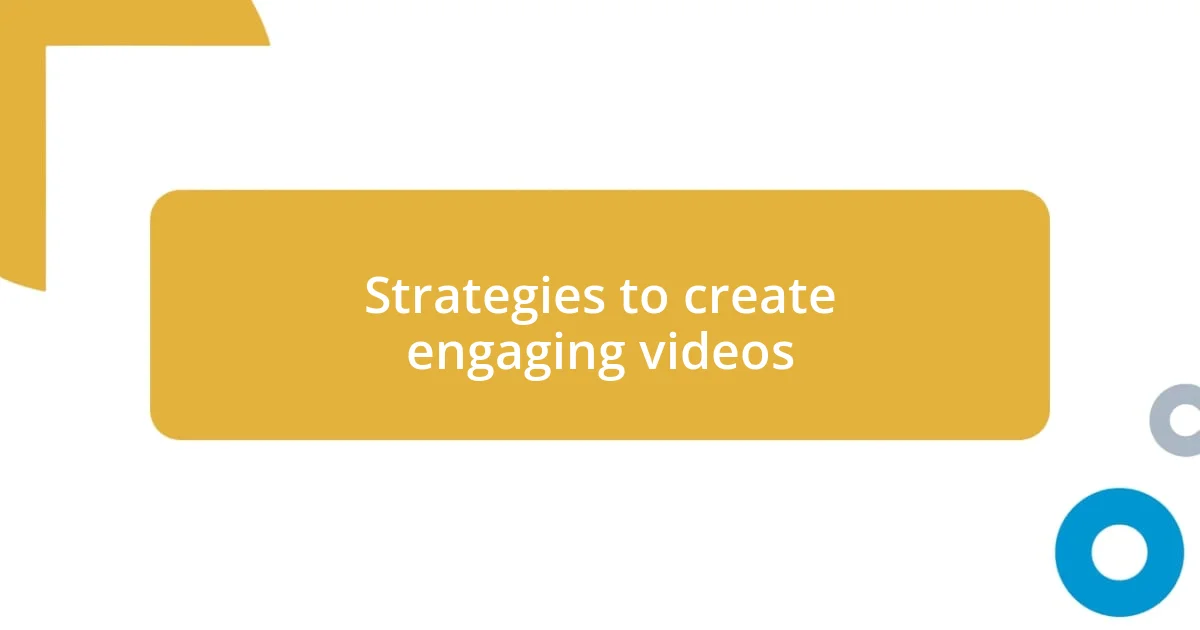Key takeaways:
- Authenticity and storytelling are crucial for connecting with audiences in video marketing, fostering real emotional connections.
- Establishing clear initial goals, such as increasing brand awareness and engagement, shapes effective video content and strategy.
- Analyzing video metrics and viewer behavior helps refine video content, enhancing viewer retention and engagement over time.

Introduction to video marketing experience
Video marketing has become a game-changer in today’s digital landscape. I still remember my first attempt at creating a promotional video for my business. I was so nervous as I pressed “record,” wondering if my message would resonate with my audience.
As I delved deeper into video marketing, I discovered its incredible ability to connect with viewers on an emotional level. Have you ever watched a video that made you laugh or cry? That’s the power of storytelling through visuals, and I found it to be an incredibly effective way to share my brand’s journey.
Through this journey, I learned that authenticity is key. When I showed my true self in videos, the response was overwhelmingly positive. It made me realize that people crave real connections, which is something I strive to foster through every piece of content I create.

Initial goals for video marketing
Setting initial goals for video marketing is crucial to ensuring a focused strategy. For me, the first step was to identify what I wanted to achieve. I needed clarity around my objectives to channel my creativity effectively.
Here’s a list of essential initial goals I considered:
- Increase Brand Awareness: I aimed to introduce my brand to new audiences through engaging storytelling.
- Boost Engagement: I wanted to create content that sparked conversations and connections with viewers.
- Educate Consumers: My goal was to share valuable insights and practical tips through educational content.
- Drive Traffic: I saw potential in using video as a tool to direct viewers to my website or social media.
Each of these goals was not only a target but a guiding principle in shaping my video content. Reflecting on them, I knew that every frame needed to communicate a purpose, resonating with the viewer’s needs and interests.

Strategies to create engaging videos
Creating engaging videos requires a thoughtful approach, and I’ve learned a few strategies along the way. For instance, I found that starting with a strong hook in the first few seconds captures the viewer’s attention immediately. When I began experimenting with eye-catching visuals and compelling questions at the beginning of my videos, I noticed a significant increase in viewer retention. This personal touch—teasing what viewers would gain by sticking around—made all the difference.
Another strategy I’ve implemented is storytelling. I remember sharing a personal mishap related to my business early on, which resonated deeply with my audience. By weaving relatable narratives into my content, I’ve fostered a sense of connection and authenticity. This isn’t just about selling; it’s about inviting viewers into my journey and making them feel part of it.
Finally, testing and iterating has been crucial in refining my video content. After releasing a few videos, I gathered feedback from my audience, asking what resonated with them and what didn’t. Adjusting my approach based on their insights has been an enlightening experience, allowing me to create content that truly speaks to their interests and needs.
| Strategy | Description |
|---|---|
| Strong Hook | Start with captivating visuals or questions to grab attention. |
| Storytelling | Use relatable narratives to create emotional connections. |
| Testing and Iterating | Gather audience feedback to refine and improve your content. |

Analyzing video performance and metrics
Analyzing video performance and metrics can sometimes feel like decoding a secret language, but once I got the hang of it, I found it to be incredibly empowering. I remember the first time I checked my video analytics; I was both excited and a bit overwhelmed by the numbers. Viewing metrics like watch time, click-through rates, and audience retention gave me insight into what was actually resonating with my viewers. It transformed my perspective—suddenly, I was no longer guessing what content would work; I was making informed decisions based on real data.
One metric that stood out to me was the engagement rate. I noticed that videos with interactive elements, like polls or questions, kept viewers watching longer. This made me think: how can I encourage my audience to participate more actively? Incorporating those interactive elements not only heightened engagement but also deepened my connection with my viewers. Each time I saw the comments and feedback pouring in, it motivated me to dig deeper into what my audience truly enjoyed.
In my experience, the true magic happens when you analyze viewer behavior post-launch. I often find myself asking, “Why did viewers drop off at this specific moment?” By revisiting those critical points, I can refine my video structure. For instance, I had a video with an intriguing hook that lost momentum during a long explanation. After adjusting the pacing and adding visual aids, I saw a noticeable improvement in retention. In essence, leveraging these metrics is like holding a mirror up to my content—it reveals the strengths and areas for improvement, paving the way for growth in my video strategy.

Overcoming challenges in video marketing
One of the biggest hurdles I faced in video marketing was overcoming the fear of being on camera. I remember my first few attempts; my hands shook, and I stumbled over my words. It’s a nerve-wracking experience! What helped me was practicing in front of a mirror and recording myself just for my own eyes. Gradually, I found my rhythm and started to feel more comfortable expressing my personality on screen.
Another challenge was navigating the technical aspects of video production. Honestly, the learning curve was steep. I spent hours watching tutorials and experimenting with editing software. There were moments of frustration when things didn’t work out as planned, but I began to embrace those “failures” as part of my growth. I found it helpful to break the process down into smaller steps, like focusing on improving one aspect of production at a time, which made everything feel more manageable.
Finally, there’s the struggle to stand out in a crowded space. With so many content creators, it’s easy to feel overwhelmed. I often ask myself, “What unique perspective can I offer?” This question led me to share my personal experiences in a way that resonates. In one memorable video, I revealed my early missteps in business, providing valuable lessons wrapped in my story. This approach not only set me apart but also built a community around shared experiences, proving that vulnerability can be a strength in video marketing.

Lessons learned from video campaigns
One of the most eye-opening lessons I learned from my video campaigns was the importance of authenticity. I remember posting a video where I tried to present myself as an industry expert, but it felt forced. The feedback I received was lukewarm at best, and I was left wondering what went wrong. It hit me then; authenticity resonates. When I embraced my true self and openly shared my journey—complete with its struggles and triumphs—my engagement skyrocketed. It was like unlocking a door to my audience’s hearts.
Another significant takeaway was the power of storytelling. In one campaign, I crafted a narrative around my business’s origin story. I used visuals to complement my words, painting a vivid picture of the challenges I faced. The response was remarkable; viewers connected with my journey on a personal level and expressed their own stories in the comments. This experience taught me that stories aren’t just filler—they’re the backbone of effective video marketing. They create bonds and build trust, which is invaluable in today’s marketing landscape.
Lastly, I discovered that consistency is key. Honestly, maintaining a regular posting schedule was tough, especially when life got busy. I often wondered, “Is it better to post less frequently if it means higher quality?” But each time I stuck to my schedule, my audience grew loyal and engaged. They began to anticipate my content, which created a vibrant community around my channel. Even during slow periods, remembering that patience and persistence pay off has been a vital lesson—and a reminder that progress often comes in waves.














